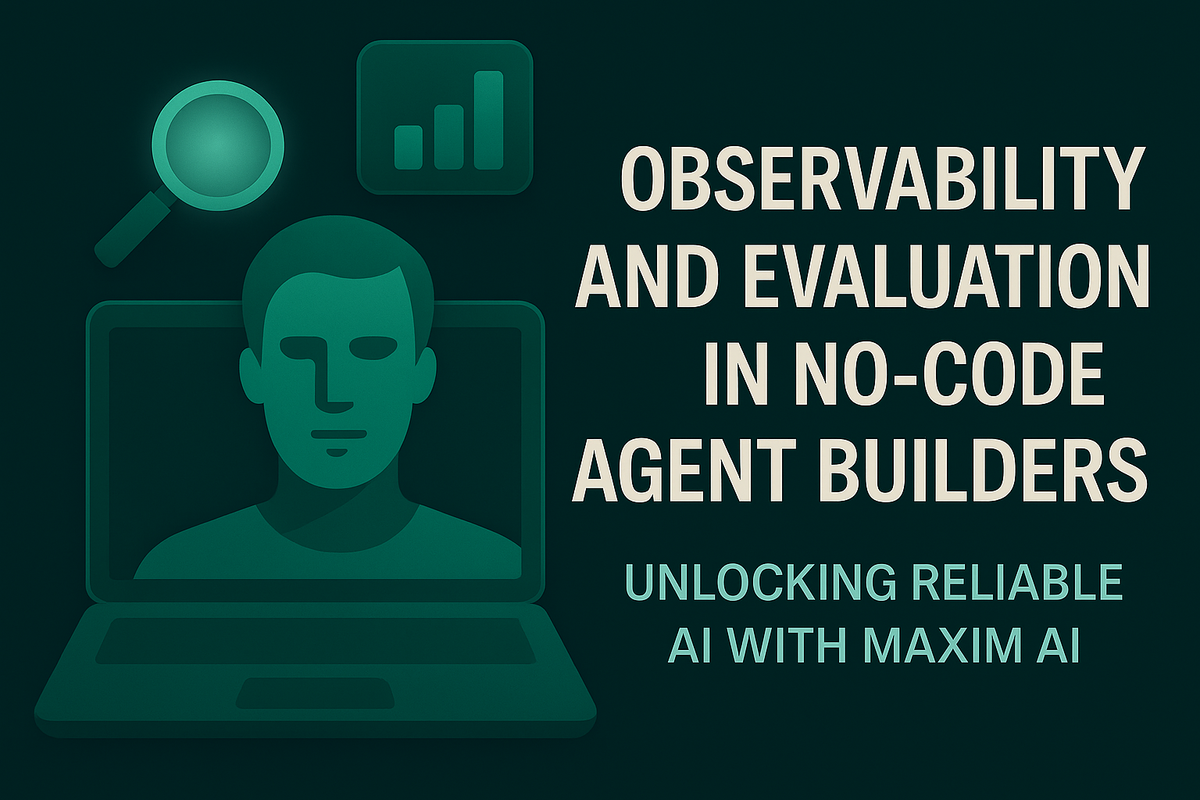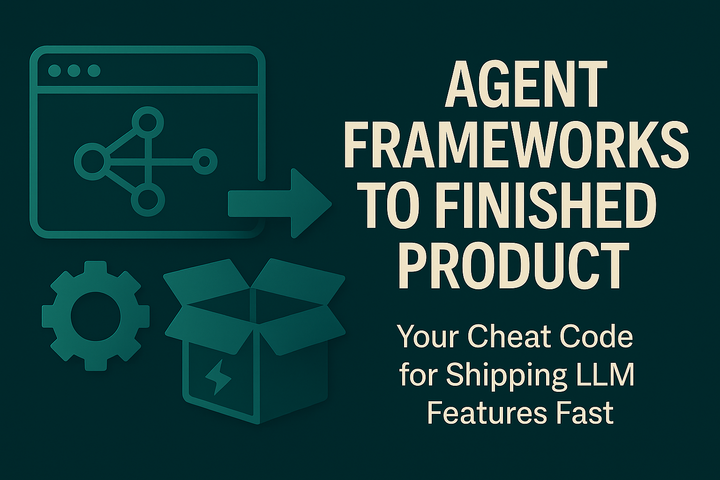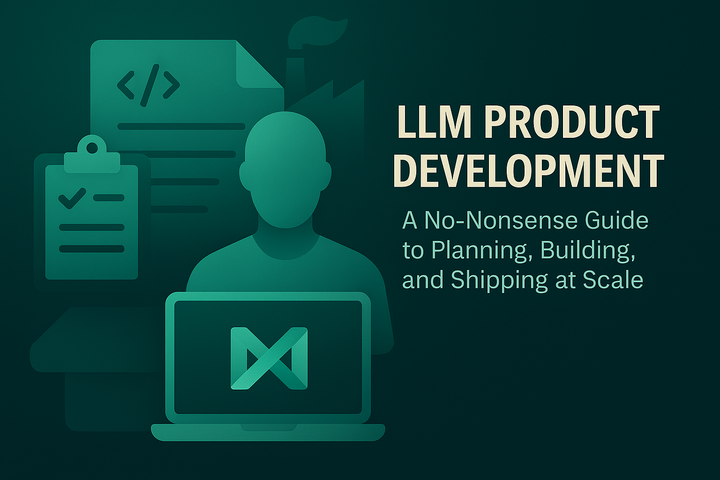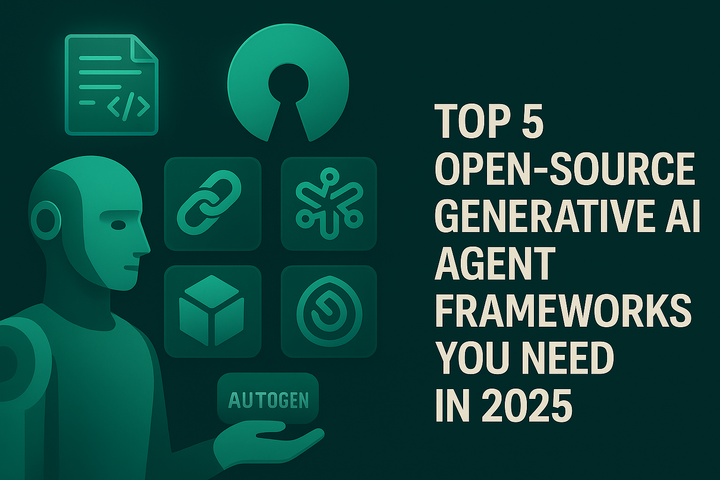Observability and Evaluation in No-Code Agent Builders: Unlocking Reliable AI with Maxim AI

The rapid evolution of AI agents is reshaping digital workflows, from customer support to real-time data analysis. As organizations seek to deploy intelligent agents at scale, no-code agent builders have emerged as a foundational tool, democratizing AI development for technical and non-technical teams alike. However, the ease of creation introduces a new set of challenges: how can teams ensure their agents are reliable, safe, and consistently high-performing in production environments? The answer lies in robust observability and evaluation—domains where Maxim AI sets the standard.
This blog explores the intersection of observability and evaluation in no-code agent builders, unpacking why these practices are essential, how Maxim AI delivers end-to-end solutions, and what best practices teams can adopt to build resilient, production-grade AI workflows.
The Rise of No-Code Agent Builders
No-code platforms such as n8n, Gumloop, and others have transformed the AI landscape by enabling users to design, deploy, and iterate on agentic workflows without writing code. These platforms offer intuitive drag-and-drop interfaces, seamless integrations, and rapid prototyping, lowering the barrier to entry for building complex agents.
Yet, as workflows grow in complexity—incorporating multi-turn conversations, tool calls, and external data sources—the risks also multiply. Agents may hallucinate, lose context, or produce outputs that are misleading or unsafe. Traditional software monitoring tools, designed for deterministic code, fall short in capturing the probabilistic nature of AI agents.
Why Observability and Evaluation Matter for No-Code AI Agents
Beyond Logs: The Unique Challenge of AI Agents
Unlike conventional software, AI agents operate with inherent uncertainty. The same input can yield different outputs depending on model parameters, context, and upstream data. Additionally, agents often execute multi-step workflows involving external APIs, memory management, and dynamic decision-making.
Standard infrastructure metrics—CPU usage, HTTP codes, or latency—are insufficient. Teams need visibility into:
- Semantic Quality: Did the agent respond accurately and helpfully?
- Reasoning Path: How did the agent arrive at its output?
- Context Management: Was conversation history preserved across turns?
- Safety and Compliance: Did the agent avoid toxic, biased, or PII-leaking outputs?
The Five Pillars of Agent Observability
Drawing from Maxim AI’s Agent Observability Guide, a comprehensive observability stack for AI agents must address:
- Traces: Capture every step—prompt, tool call, model invocation, and retry—across distributed components. Rich traces enable replaying sessions and pinpointing failures.
- Metrics: Monitor latency, token usage, cost, and throughput at granular levels, tied to service-level objectives.
- Logs & Payloads: Persist raw prompts, completions, and intermediate responses for forensic analysis.
- Online Evaluations: Continuously score outputs for faithfulness, toxicity, and other metrics, triggering alerts when quality degrades.
- Human Review Loops: Route flagged outputs to subject matter experts for final validation.
Maxim AI: Purpose-Built Observability and Evaluation for No-Code Agents
Seamless Integration with No-Code Platforms
Maxim AI’s platform is designed to work with leading no-code agent builders. Whether you’re orchestrating workflows in n8n, Gumloop, or custom stacks, Maxim’s SDKs and no-code interfaces provide deep tracing, automated evaluation, and real-time monitoring—without requiring code changes.
- Framework Agnostic: Integrates with OpenAI, Anthropic, LangGraph, Crew AI, and more (see integrations).
- OTel Compatibility: Maxim’s SDKs are OpenTelemetry-compatible, allowing you to forward traces and logs to third-party observability platforms such as New Relic or Grafana (learn more).
- Visual Trace View: Hierarchical timelines help teams debug multi-step workflows, analyze agent reasoning, and resolve issues quickly (Maxim Docs).
Automated and Human-in-the-Loop Evaluation
Maxim AI offers a library of pre-built evaluators and supports custom metrics, enabling teams to assess agent outputs for:
- Clarity
- Conciseness
- Faithfulness
- Toxicity
- PII Leakage
- Domain-specific criteria
Human annotation queues allow flagged outputs to be reviewed by internal or external experts, closing the last-mile validation gap (Evaluation Workflows).
Real-Time Alerts and Dashboards
Customizable alerts notify teams of regressions in latency, cost, or semantic quality, integrating with Slack, PagerDuty, or webhooks for rapid response (Docs: Alerts).
Case Studies: Observability and Evaluation in Action
Event Discovery Agent with n8n and Maxim AI
In Built an Event Discovery AI Agent using No-Code under 15 mins, the workflow uses n8n to create an agent that fetches public event data from Google Sheets, maintains conversation history, and responds to user queries. By integrating Maxim AI for evaluation, the team was able to:
- Simulate multi-turn conversations to test context retention and output accuracy.
- Run automated evaluations for relevance, clarity, and helpfulness.
- Refine prompts and data sources based on evaluation feedback.
- Rapidly iterate and deploy improvements, reducing manual testing time.
Reddit Insights Agent with Gumloop and Maxim AI
The Building and Evaluating a Reddit Insights Agent with Gumloop and Maxim AI case study highlights how Maxim’s evaluation framework transformed raw LLM output into production-grade intelligence. By running targeted evaluations for clarity, conciseness, and coherence, the team:
- Identified and resolved narrative drift and redundancy in outputs.
- Leveraged Maxim’s dashboards to compare evaluation runs and track improvements.
- Integrated human-in-the-loop reviews for nuanced criteria.
Best Practices for Observability and Evaluation in No-Code Agent Workflows
1. Instrument Early and Continuously
Begin tracing and evaluating agents from the earliest prototyping stages. Maxim’s no-code quickstart guides make it easy to instrument agents without developer intervention (SDK No-Code Agent Quickstart).
2. Define Clear Evaluation Metrics
Select metrics that align with business and user goals—faithfulness for factual accuracy, conciseness for readability, and safety for compliance. Customize evaluators for domain-specific needs (AI Agent Evaluation Metrics).
3. Monitor in Real Time
Set up online evaluations and real-time alerts to detect drift, regressions, or failures before they impact users (Agent Observability).
4. Close the Loop with Human Review
Automated metrics catch most issues, but human expertise is vital for edge cases, nuanced language, and compliance. Use Maxim’s annotation queues to route flagged outputs to reviewers (Evaluation Workflows for AI Agents).
5. Iterate Rapidly
Leverage Maxim’s dashboards and reporting tools to track progress, compare versions, and drive continuous improvement (Experimentation).
Conclusion
No-code agent builders have made AI development accessible and efficient, but reliability, safety, and quality cannot be left to chance. Observability and evaluation are the bedrock of production-grade AI workflows, ensuring agents perform as intended, adapt to changing contexts, and remain aligned with organizational standards.
Maxim AI delivers a unified, enterprise-ready platform for tracing, evaluating, and monitoring no-code agents—empowering teams to move fast without sacrificing rigor. Whether you’re building chatbots, workflow automation, or data-driven insights agents, integrating Maxim AI is the key to unlocking scalable, trustworthy AI in production.
Ready to elevate your agentic workflows? Schedule a demo with Maxim AI or explore the Maxim Docs for step-by-step guides.


